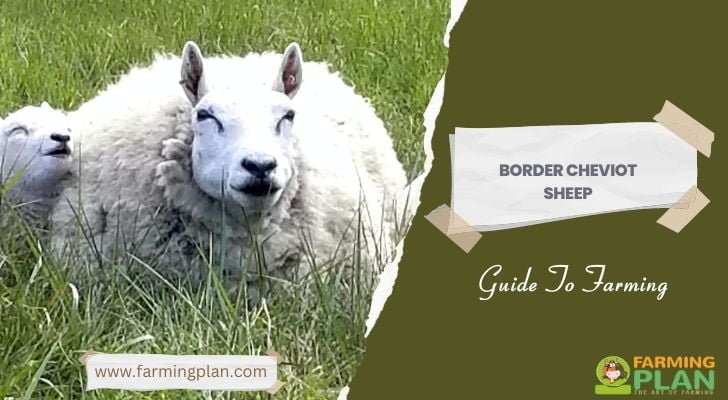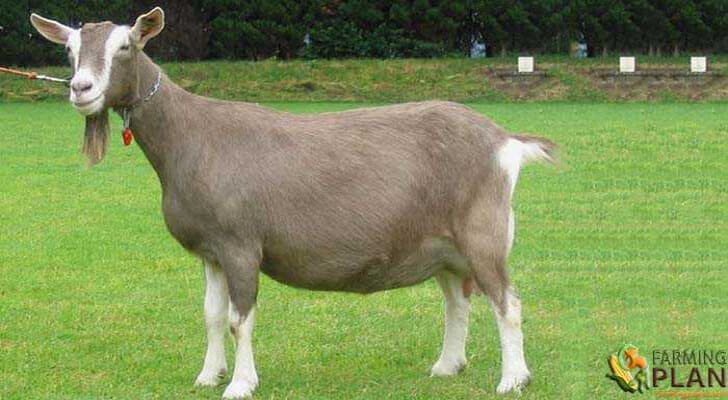Are you dreaming of starting your farm and growing a profitable business? Then why not consider raising Border Cheviot Sheep? Popularly known as the South Country Cheviot, these hardy sheep originated in the Cheviot Hills around England and Scotland. They are versatile yet docile creatures that can thrive in various environments. This blog will guide you through everything you need to know to start a prosperous sheep farm from scratch – from selecting breeds to harvesting products – including all the considerations for land requirements, breed characteristics, breeding strategies, health management protocols, and more! By following this advice, you’ll find yourself well on your way to cultivating an idyllic lifestyle with plenty of profits.

History & Origin
The Border Cheviot Sheep has a rich and colourful history dating back centuries. Believed to have originated in the Cheviot Hills between England and Scotland, these sheep were used extensively by shepherds in the region for their hardiness, adaptability, and resistance to disease. Over time, their popularity grew, and the Border Cheviot became one of the world’s most sought-after breeds of sheep. Today, these charming creatures are treasured for their beautiful white wool and gentle nature and can be found in many different parts of the world. Despite their long and storied past, Border Cheviots inspire awe and admiration in those lucky to encounter them.
Characteristics
Border Cheviot Sheep are a unique breed known for their distinct characteristics. These hardy animals are well adapted to their cold and often harsh surroundings, making them a popular choice for farmers in northern regions. One of the defining physical features of the Border Cheviot Sheep is their white, woolly fleece. Their heads and legs are wool-free, giving them a sleek and elegant appearance. Beyond their physical traits, these sheep are also valued for their intelligence, alertness, and adaptability. Border Cheviot Sheep are famous for their hardiness and versatility and continue to thrive in traditional and modern farming practices.
Feed
Border Cheviot Sheep are known for being hardy and adaptable, making them the perfect breed for many farmers. As with any animal, their health and well-being are paramount; a significant part is nutrition. Feeding Border Cheviot Sheep involves providing the correct balance of energy, protein, minerals, and vitamins to help them thrive. These sheep can benefit from a diet that includes high-quality forage, such as hay and grass, supplemented with grains or pelleted feed to meet their nutritional requirements. With the proper care and attention, Border Cheviot Sheep can lead healthy and productive lives on the farm.
Usage
Border Cheviot Sheep have been a popular breed of sheep for centuries. These hardy and adaptable animals originated in the Scottish Border region and are known for their excellent meat and wool production. Farmers and ranchers alike appreciate the durability and resilience of the Border Cheviot Sheep, as they can thrive in harsh environments and graze on rough terrain. In recent years, the demand for this breed has increased due to their versatility and adaptability to different environments. The Border Cheviot Sheep is an excellent choice whether you want to raise sheep for meat or wool. They are easy to handle and care for and, with proper management, can be a profitable addition to any farm or ranch.
Unique Feature of Border Cheviot Sheep
Border Cheviot Sheep are a distinct breed of sheep raised in the Scottish Borders for centuries. These sheep are known for their hardiness and adaptability, as they tolerate harsh weather conditions and rugged terrains. They have a white, woolly coat and distinctively short ears that have earned them the nickname “Baldies.” The Border Cheviot Sheep has a rich history and has been integral to the rural economy of the Scottish Borders. Today, they are popular among farmers for their meat and wool and show competitors who appreciate the breed’s unique qualities. If you want to learn more about the Border Cheviot Sheep, you’ll discover a fascinating history and unique characteristics that make this breed stand out.
Understand the basics of Sheep Farming
Sheep farming can be rewarding, but it requires plenty of knowledge and attention to detail. One breed that’s worth getting to know is the Border Cheviot sheep. These hardy animals are well-suited to the rugged landscape of the Scottish Borders, where they originate from, and have been bred for their meat, wool and milk. Its distinctive white face and wool-free black legs set the Border Cheviot apart from other breeds. They’re also known for their intelligence, which makes them easier to handle, and their adaptability, which means they can thrive in different climates worldwide. So, whether you’re a seasoned farmer or just starting, learning about the Border Cheviot sheep can be a fascinating and valuable investment.
Research the local laws
If you want to start or expand a sheep farm in your area, it’s important to research local laws, regulations, and zoning rules. This holds for any type of sheep breed, including Border Cheviot Sheep. By taking the time to understand the legal requirements for raising sheep in your area, you can ensure that your farm is following the rules and regulations that will help you maintain success in the long run. Additionally, staying up-to-date on local zoning rules can help determine whether your farm is allowed in your chosen location. Remember that these regulations vary depending on your area, so you must check with local authorities for the most accurate information. With the proper knowledge and preparation, you can create a prosperous sheep farm that follows the law and fosters healthy and happy animals.
Create a Business Plan
Starting a Border Cheviot Sheep farming business can be exciting and rewarding. However, before jumping into it, you need to create a comprehensive business plan that will guide you in achieving your goals and staying on track. The plan should cover everything from finances to marketing and customer acquisition tactics. Once you have the plan, you must obtain the necessary permits to operate your business legally. This means researching and acquiring all the licenses and permissions required by your local and state governments. With these steps in place, you’re ready to start your Border Cheviot Sheep farming business and fulfil your passion for raising these beautiful animals while making a profit.
Find land Suitable
Are you looking to start your own Border Cheviot sheep farm? The first step is finding the perfect piece of land to raise these incredible creatures! These hardy little sheep are famous to farmers worldwide with their distinctive black and white markings. However, finding land suitable for grazing and breeding these sheep can be challenging. You want to ensure enough space for your flock to roam and plenty of fresh grass and water to keep them healthy. So, whether you’re a seasoned farmer or just starting, finding the right piece of land for your Border Cheviot sheep is essential to making your farm successful.
Purchase or Build Livestock Pens
As a Border Cheviot Sheep owner, you know that providing the right living conditions is crucial to keeping your flock happy and healthy. Whether you’re just starting or looking to expand your operations, purchasing or building livestock pens, shelters, and hay storage facilities should be at the top of your to-do list. Your sheep will need durable and safe structures that can withstand the ever-changing weather, provide ample space to graze and rest and protect them from predators and other threats. With suitable structures in place, you can offer your Border Cheviot Sheep a comfortable home and ensure their well-being for years.
Acquire Your First Flock
If you’re considering adding sheep to your farm or homestead, Border Cheviot Sheep is a beautiful breed. These hardy sheep are known for their resilience and versatility. To ensure you acquire a healthy and thriving flock, it’s important to find reputable breeders who are knowledgeable about the breed and dedicated to raising healthy, happy animals. A good breeder can help you select the right sheep for your needs and provide advice and support as you get started with your new flock. With patience, attention, and hard work, you’ll soon enjoy all the benefits of raising these delightful animals.
FAQ
What size are Cheviot sheep?
Border Cheviot Sheep is a breed of sheep originating from the hills of Scotland and Northern England. These sheep are known for their resilience and hardiness, which have made them a favored breed for farmers all across the globe. The size of a Cheviot sheep can vary depending on whether it is a male or a female. Typically, males weigh around 60-100 kg and stand at a height of around 90 cm, while females weigh around 50-80 kg and reach a height of around 80 cm. Despite their compact size, they pack a lot of strength, making them well-suited for working in harsh, mountainous terrain. The Border Cheviot Sheep is worth considering if you’re looking for an intelligent and hardworking breed of sheep.
What is the Cheviot breed of sheep known for?
The Cheviot breed of sheep is a beautiful animal known for its hardiness and adaptability to various environments. These sheep are named after the Cheviot Hills on the border of England and Scotland, where they were first developed. The Border Cheviot Sheep is a hardy breed that withstands harsh weather conditions. They have a thick, white fleece with a distinctive wool tip, making them a popular choice for wool production. The Cheviot sheep is also known for its excellent meat quality, making it a favorite choice for farmers and consumers. With their energetic personality and strong will, the Border Cheviot Sheep embodies the resilience and persistence of the Scottish people in the face of adversity.
Where are Cheviot sheep from?
Border Cheviot Sheep are one of the oldest native breeds of the British Isles. For centuries, these resilient sheep have been thriving in the rugged and often harsh landscape of the Cheviot Hills, which straddle the border between England and Scotland. With their distinctive white wool and small, alert ears, they are instantly recognizable. They are a hardy breed that can withstand winter conditions and are well-suited to various terrains. Today, Border Cheviot Sheep are found in the UK and many other countries worldwide, where they are increasingly appreciated for their adaptability, versatility, and natural hardiness.
Conclusion
In conclusion, the Border Cheviot Sheep is a hardy and versatile breed of sheep well suited to various farming setups. Its thick fleece and easy lamb production have been a valuable addition to many a flock for generations. Whether you have been considering getting some for your farm or are just interested in learning about this beautiful breed, knowing its origin, characteristics, feed requirements, and other special features can go a long way in helping you decide what will be best for you. From researching the local laws and regulations beforehand to tracking down suitable land and purchasing the sheep themselves, there’s quite a lot of work involved in owning them. However, if you put in the effort now and stick to it, chasing after your dream of becoming a successful shepherd could soon become a reality.


